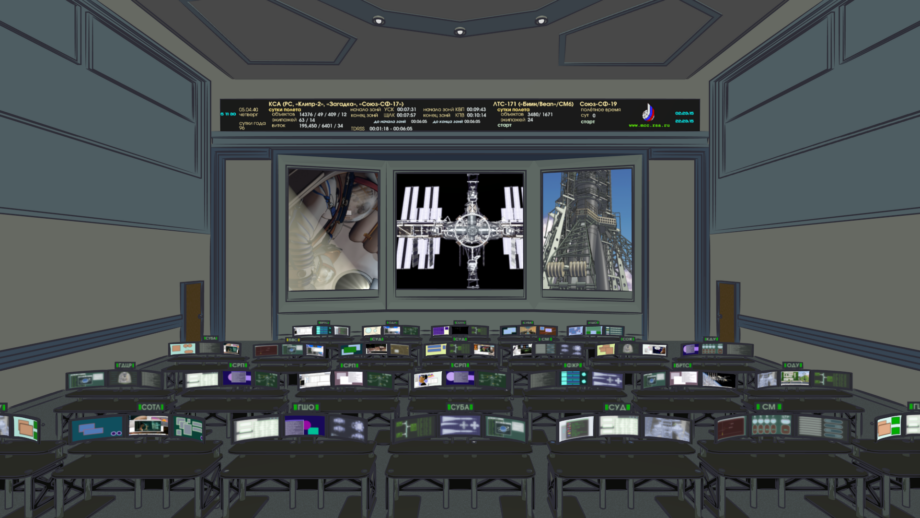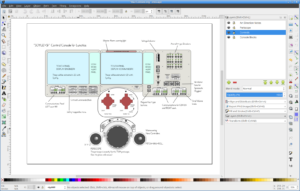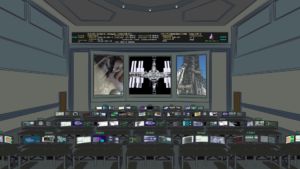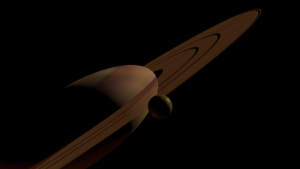Highlights
- Mission Control Room, monitor animation and flicker effect test.
- Soyuz interior set rigging, with controls for lights, LED indicators, and video screens (requires New Depsgraph). Documented fully.
- Ironically, Facebook suggested I “boost” the post about how I’m going to stop using Facebook so much for “Lunatics!”
- Considered rewards for a possible “release” Kickstarter.
- Fanart model of “Mesklin” from “Mission of Gravity”.
- Created channel art for the YouTube channel.
- Watched a lot of tutorials this month to figure out constraints and drivers I needed to do for the Soyuz interior set re-rigging.
- Animation review and direction for the Press Conference scene.
- There was a major timing problem due to the files being set to 24fps instead of 30fps while doing the lipsync animation.
- Developed the screens and lighting effects for the Mission Control Room set.
- Revisited the effects work for the Lunar landing retro-rockets.
- SVN Commits: 580-590.
Soyuz Console Plan – Found it!
I spent hours looking for this yesterday. It’s one of the earliest of our mechanical art design works — the design (and label texture) for the Soyuz console (which we modeled in a pilot project in 2012). So I knew I would have to do some digging to find it. I noticed some misspellings in the texture used in the actual set file, and wanted to update it from this.
After an extensive search using GNU’s “find” as well as checking through all the old places I used to put stuff, I didn’t find the final version, although I finally did find an early revision that I might have been able to update. I decided to save that into the place “where it belongs” in the new source tree, as a new starting point.
At which point, I found this file (which is the final version) already there! (With a filename that didn’t quite match anything I searched for).
Moral of this story: Always look “where it belongs”, first, even if you’re sure you didn’t put it there!Second moral of the story: We really need to migrate our stuff into TACTIC! (the digital asset / project management system we’re planning to use).
Soyuz Set (Test Render)
This is the updated / rebuilt Soyuz interior set. Chris Kuhn created this set based on the previous model, but at a much lower polygon count. There are a number of other small design changes, as well, and this model is slightly more accurate to the real thing.
What I’m doing now is to refine and add extra modeling detail; re-rig the controls for easier animation; bring the materials up to spec with our non-photorealistic (NPR) style; and to set up layers, lighting, and cameras for all the animation we need to do with it.
Explanation of Console Lights and Screens Rigging
Materials Rigging for Console Lights and Screens
This week, I’ve just about completed finishing work on the Soyuz-SF Descent Module Interior (SDM) set. A major feature of this set is the complex console which has many lights and screens we want to be able to animate. These elements are represented by materials with “emit” values and video textures.
In this Production Log post, I explain how I rigged the animation controls for the Soyuz console. It’s a finicky business which takes advantage of some of the latest features from Blender 2.78, but it works nicely!
Mission Control Center (Test Render #2)
Another view of the control center for the launch sequence in Part 1 of “No Children in Space”. This is a long-lens view across the row, showing the medical monitors and the position where the controller we hear over the communications system is sitting.
We assume a higher level of automation in the future, so there aren’t as many controllers dedicated to the launch in our story. Instead, many of the other controllers are engaged with space station operations and the docking Moon Shuttle, which is happening at about the same time.
CREDITS information for the MCR Set:
Set plans were drawn by Terry Hancock, based on reference photos.
Travis Souza modeled the room, desks, and monitors.
The chairs are a BlendSwap model by user Lekanus (Public Domain/No License).
The monitor displays were made by Terry Hancock, using various methods, including real screen captures, drawings in Inkscape, and animations using Synfig Studio.
Some of the images include mech models created by Chris Kuhn.
MCR Monitor Flicker Effect Test
I wanted the monitors in mission control to look “live”, so a few of them are animated, and all of them have a slight flickering effect. This was much more noticeable with CRTs. I’m not sure that’s it’s very realistic to use with what are supposed to be LCD or OLED monitors, but it does look kind of cool.
The effect is achieved by animating a 4-frame cycle (probably could be just 2-frames, but I have alternating cycles of slightly different depth), animating the material “emit” property of each monitor’s material, as well as the intensity of a bluish “hemi” light positioned at each console.
In this case, I used drivers to control all the separate material’s emit properties from a single property that was animated. I later realized there is a slightly easier method using a single material node, which I used on the Soyuz interior set, and may port back into this model (or not, since the driver system is already done).
I’ll be documenting this material node method in this week’s Production Log entry.
Mission Control Room (Test Render)
We’re moving into finishing sets for “Part 1”. This is the mission control center, with the monitors assigned (108 total!). A few of them are animated, while most just have a small amount of flicker. (Extras will be added at the scene level).
As this is a Soyuz launch, this is meant to be a future, upgraded version of the RKA mission control center, near Moscow, with only minor changes.
This will be on screen only very briefly, but I think it’s important to completely situate the launch sequence, since we’re emphasizing the similarities to present-day launches.
Video Summary
Art
Check Renders for Press Conference
Testing that everything is rendering correctly.
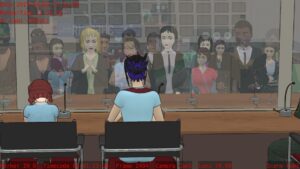 |
 |
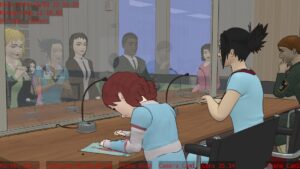 |
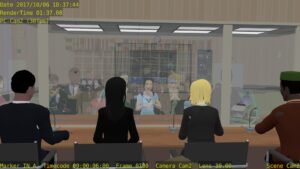 |
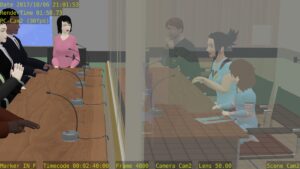 |
 |
 |
 |
Soyuz-DM Interior
The “Descent Module” is also the “Ascent Module” — it’s the bell-shaped part of the Soyuz orbiter, which the crew ride in on acceleration couches. The ball-shaped part on the top/front is the “Orbital Module”, which has some living space used during zero-gee flight. For our episode, the action is all in the DM.
We had built a version of this set as our first project in 2012, but there were a lot of technical problems with that set, and it wasn’t as accurate as I wanted. This year, Chris Kuhn recreated the model, using diagrams I found for him, and the original model for reference (particularly the control console, which differs a lot from present-day Soyuz).
The new model also features a complex animation control panel to handle the lights, acceleration couches, and so on:
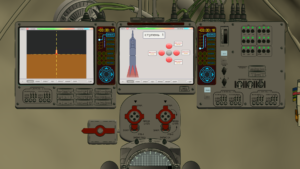 |
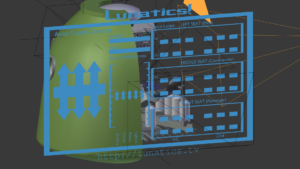 |
 |
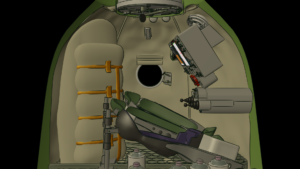 |
Mission Control Room Set
This set was created mostly by Travis Souza, based on drawings and references I made and/or found. The set is based on a real room, but all the equipment and furniture is new (except perhaps for the large monitors on the front wall).
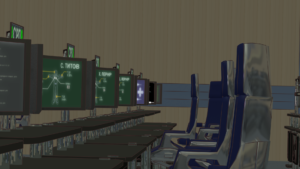 |
 |
Fanart
My concept of Mesklin from “Mission of Gravity” by Hal Clement, created in Blender (just for fun). The most notable feature of the planet is its extreme oblateness, due to spinning very rapidly. This allowed Clement to have a planet with a tolerable surface gravity near the equator, though it was crushing at the poles. Not sure how plausible this sort of planet actually is, but I tried to keep it consistent with the description in the book (and the appendix, “Whirligig World”). The moon in the foreground is “Toorey”, the location of the human research base referred to extensively in the story.
